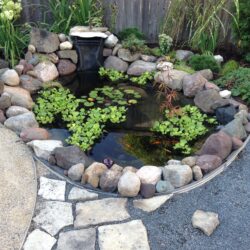How to Use Natural Stone to Create At Home Water Features
Being near water has a calming effect and research studies have shown that water features can positively contribute to our overall mental health and well-being. Incorporating natural stone water features at home can bring both beauty and tranquility into your space.
Anne Roberts, president of Chicago based Anne Roberts Gardens Company, finds that people love the sound of water because it’s relaxing. Since not every home has a water feature, adding one is a way to make your home stand out.
Michael Zimber, founder of Santa Fe-based Stone Forest, often uses natural stone in his water feature designs. According to Zimber, many homeowners choose to add a water feature to their outdoor spaces for aesthetic reasons or because it goes well with other elements in their space. “Water features add a dramatic focal point in the garden space; a tapestry of sound, visuals, and texture that attracts birds and other wildlife (including the human variety),” Zimber says. Another benefit? Water features mask road noise quite effectively.
Why add a natural stone water feature
There are countless options for natural stone water features in landscape design, including fountains, basins, waterfalls, ponds, and pools. More elaborate designs include computerized water features synchronizing music to water and light animation, like what you might see in Las Vegas or the front of some hotel properties.
- Photo by Karen Hardy
- Photo by David Hoptman
Natural stone fountains will last for generations, according to Zimber. In addition to helping mask road noise, natural stone water features can become a focal point or help define a garden space.
Contrary to what some people might think, a water feature doesn’t have to be large like a pool or big waterfall design. “Natural stone water features can be as big or small as you have space for,” Roberts says. Her company has installed smaller streams with recycling water systems, small foot ponds, and even large natural dry riverbeds for water that periodically overwhelms areas in one’s yard.
What to consider when installing a natural stone water feature
Natural stone water features can make a dramatic statement, whether as a focal point of a space or background statement. There are several things to take into consideration when choosing a water feature, including price and maintenance. Here are a few additional things to consider when choosing your water feature.
- The size of the reservoir. Both Roberts and Zimber remind clients that the final design needs to fit the desired space.
- Size and weight of the water feature. If a sizeable fountain is being considered, for example, how will it be installed? Will it require a dolly/ hand truck, forklift, or crane?
- Incorporate plants. This will be geography dependent, but something to think about as you’re deciding the location of your water feature. In the southwest where Zimber is based, it’s all about drought tolerant species. “It’s nice to ‘layer’ different perennials around the water feature,” he says.
- Let the light in. Adding lighting systems will bring some visual interest to your space during the night.
- Consider short- and long-term maintenance. In addition to making sure pumps and other accessories are in working order, homeowners will want to add cleaning the reservoir to their calendar once a year, Zimber says. He also recommends using an algaecide that is bird and animal-friendly, along with a weekly dose of a chemical to fight hard water buildup.
Types of natural stone water features
Natural stone water features can be true works of art in an outdoor space and part of their appeal is they engage several of our senses. Not only can they provide a soothing backdrop from the movement of water over the stone, but they provide a striking visual with their textured designs.
When choosing a water feature like a fountain or basin, you want one that will be built to last in your environment. “Granites and basalt can handle cold environments and will last for generations,” Zimber says. Some gravitate toward stunning marble and onyx fountains which may not hold up quite as well, but generally will withstand the life of the garden and homeowners, Zimber adds.
In addition to the water feature, most pieces include rocks or smaller stones beneath the focal point to capture the movement of the water.
- Anne Roberts Garden Company
- Anne Roberts Garden Company
Zimber and his team design and carve natural stone fountains. Their designs range from traditional Japanese and Old World to natural or monolithic contemporary. Fountain shapes can be in a boulder shape, millstones, sphere, or vertical. They truly can be customized to your unique space, interests, and budget.
One of the most common mistakes Zimber sees with homeowners and water features is sub-standard installations. If you’re not planning to hire a professional to install your water fountain, Stone Forest has a blog post on creating a successful fountain installation that Zimber directs people to so they can do it themselves correctly. Another mistake Zimber sees is buying a cheap foundation made of concrete. Those, he says, tend to fall apart after a few seasons.
If the project is beyond your DIY capabilities, Roberts highly recommends hiring a firm with experience installing water features such as ponds as not every landscape has that expertise.
Once you install a natural stone water feature, you’ll be able to enjoy it for decades.











